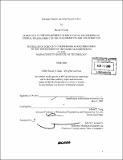Business plan for the Solar Recycle-o-Sort
Author(s)
Kalk, David O. (David Oliver)
DownloadFull printable version (5.162Mb)
Other Contributors
Massachusetts Institute of Technology. Dept. of Mechanical Engineering.
Advisor
Maria C. Yang.
Terms of use
Metadata
Show full item recordAbstract
There exists much room for growth in recycling participation with almost 1 in every 4 Americans still not recycling at all. In many communities this fraction is significantly higher, with low awareness of the benefits of recycling. A group of MIT students developed a product called the Solar Recycl-o-Sort as part of their senior design class 2.009: Product Engineering Process. This solar-powered stand-alone recyclable sorter is able to differentiate and sort between glass bottles, plastic bottles, aluminum cans, and trash. The ability to watch the sorting and distributing, as well as an LED feedback display makes recycling fun and interactive. This product makes recycling exciting and will also educate users about recycling, resulting in increased community participation. Transitioning from the developmental stage into the stages of marketing and sales requires a business plan. This document serves as that plan and helps to organize the engineering work of the team into a document, while combining it with business discussion and strategy. Necessary financial projections and analysis were added in order to assist the team in obtaining outside funding. The product will be marketed to communities and municipalities primarily as a means of recycling promotion, but also as a way of combating neighborhood trash problems. As the premier product of its kind, it faces little competition and has the potential to become further competitive in waste collection industry if a crushing mechanism is introduced. Financial forecasting has determined a funding need of $125,000 in order to prepare the product for mass production. Such financing would be in return for a 49% equity stake in the company, and this investment would return a 36% ROI over the first five years.
Description
Includes bibliographical references (leaf 32). Thesis (S.B.)--Massachusetts Institute of Technology, Dept. of Mechanical Engineering, 2008.
Date issued
2008Department
Massachusetts Institute of Technology. Department of Mechanical EngineeringPublisher
Massachusetts Institute of Technology
Keywords
Mechanical Engineering.